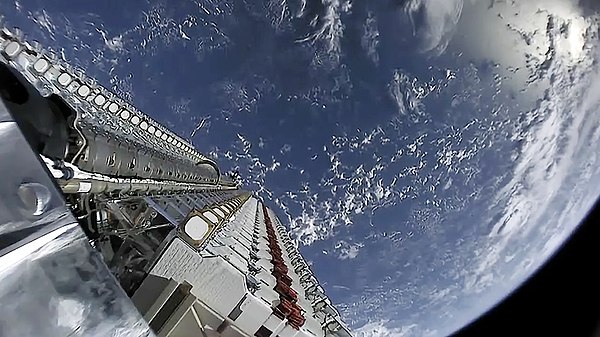Difference between revisions of "Starlink"
| Line 1: | Line 1: | ||
[[File:Starlink Mission (47926144123).jpg|thumb|600x600px]] | [[File:Starlink Mission (47926144123).jpg|thumb|600x600px]] | ||
'''Starlink''' is a [[satellite constellation]] currently being constructed by [[SpaceX]] to provide fast internet access worldwide. | '''Starlink''' is a [[satellite constellation]] currently being constructed by [[SpaceX]] to provide fast internet access worldwide. | ||
| − | It may eventually be used at Mars to provide Interplanetary communications. | + | |
| + | It may eventually be used at Mars to provide [[Interplanetary communications]]. One of the stated goals of Starlink is to provide a constant revenue to finance SpaceX's Mars settlement plans. | ||
==History== | ==History== | ||
| Line 8: | Line 9: | ||
Total satellites currently working (16 May 2021): 1578 | Total satellites currently working (16 May 2021): 1578 | ||
| − | == Technology == | + | ==Technology== |
The satellites will employ optical inter-satellite links and phased array beam-forming and digital processing technologies in the Ku- and Ka-bands<ref name=":0">Wikipedia Starlink article : https://en.wikipedia.org/wiki/Starlink</ref>. | The satellites will employ optical inter-satellite links and phased array beam-forming and digital processing technologies in the Ku- and Ka-bands<ref name=":0">Wikipedia Starlink article : https://en.wikipedia.org/wiki/Starlink</ref>. | ||
Revision as of 07:37, 18 May 2021
Starlink is a satellite constellation currently being constructed by SpaceX to provide fast internet access worldwide.
It may eventually be used at Mars to provide Interplanetary communications. One of the stated goals of Starlink is to provide a constant revenue to finance SpaceX's Mars settlement plans.
History
The first concept of Starlink was first announced in January 2015[1] by Elon Musk. The project was kept closely under wraps for the next four years until scheduling the launch of the first batch of experimental Starlink satellites in May 2019.[2] These sixty satellites launched aboard a Falcon 9 on 24 May 2019 from SLC-40 at Cape Canaveral Air Force Station.
Total satellites currently working (16 May 2021): 1578
Technology
The satellites will employ optical inter-satellite links and phased array beam-forming and digital processing technologies in the Ku- and Ka-bands[3].
Starlink satellites use Hall-effect thrusters with krypton gas as the reaction mass for orbit raising and station keeping. Krypton Hall thrusters tend to exhibit significantly higher erosion of the flow channel compared to a similar electric propulsion system operated with xenon, but have a lower propellant cost[3].
References
- ↑ Elon Musk Announces Plan for Internet Satellite Network 2015. YouTube.
- ↑ "Starlink Compendium". ElonX. December 21, 2019.
- ↑ 3.0 3.1 Wikipedia Starlink article : https://en.wikipedia.org/wiki/Starlink







